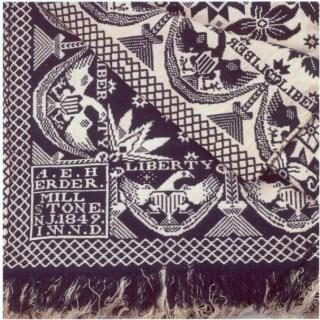Antique Coverlets - An American Heirloom

A coverlet is a type of bedspread fashioned by weaving on a loom. In Colonial days the master bed often accommodated not only mom and dad but several other family members as well. As the prominent article of furniture in most homes, the bedstead was beautifully arrayed. Although few of our foremothers could afford silk and damask, America's large variety of early woven blankets represents a sophisticated, decorative and much sought after remembrance of her past.
Coverlets were made in single, called "single woven," and "double woven" layers. Germanic immigrants were prone to the former while Scottish and English weavers seemed drawn to the latter. Most commonly, a foundation of bleached cotton or linen, the warp, was interlaced with wool, the weft, that readily accepted coloring agents of blue indigo (by far the most popular dye), dogwood and bloodroot (red), goldenrod (green), butternut bark (brown) and bittersweet (orange). Synthetic dyes were introduced just prior to the Civil War. More than age or rarity-good condition, graphic color and design, and historical significance are the major determinants of coverlet value. Collectors and dealers categorize their heirlooms as follows:
Overshot Coverlets: Also know as the float weave, 18th and rural 19th century examples made by home and itinerant weavers on four-harness looms that were once as common a household appliance as dishwashers are today. Because they were fashioned on crude weaving machines, Overshot Coverlets are necessarily geometric in design incorporating a wide variety of stripe, square, diamond, medallion and other patterns. Made in two parts, they are always seamed in the middle. These readily available coverlets are undervalued and compliment 18th century and high country design.
Double Weave Geometric, Summer Winter, and Star Work Coverlets: Forerunners of sophisticated Jacquard bedspreads these professionally woven second-stage examples feature strong clear geometric design, flat to the surface tight weaving, and double-facing; in that the weaving on the back is the precise decorative reverse of that on the front.
Jacquard Coverlets: The Jacquard loom was first introduced by its inventor, Joseph Marie Jacquard (1752-1834) at the National Exposition in Paris in 1801. It is a player piano-like device that facilitates reproducible complex woven designs using multiple sets of perforated cards that orchestrate a weaving machine like an ancestral computer. Jacquard's initial inspiration for his invention was an extract from an English newspaper offering a premium to "any man who should weave a fishing net by machinery." Accomplishing his goal, Jacquard was soon arrested by Napoleon Bonaparte's magistrate. "Are you the man who pretends to do that which God Almighty cannot do, to tie a knot in a stretched string?" the magistrate named Carnot inquired. Jacquard was granted three weeks to reproduce his feat or spend his days knitting in prison. The refined loom landed on American shores in the 1820's. Professionally woven Jacquard Coverlets are distinguished by bold colors, tight weave, double-facing, pictorial centerfield designs, and wide often striking borders incorporating designs like American eagles, railroads, lions, buildings, trees, ships and other elements. While I have seen two-part Jacquard coverlets, most were produced full size without a middle seam. In the corner block of his coverlet the weaver often included his name, the name of the owner/contractor, the owner's town, county, state, and date of weaving.
Even when they were loomed, great coverlets have always been considered a household treasure. Frequently mentioned in wills and safely stored for future generations in dower chests, they truly are American heirlooms.
